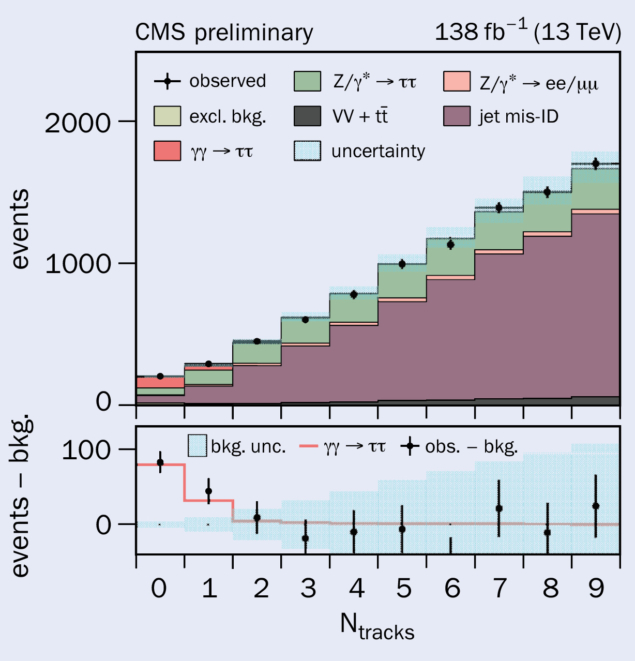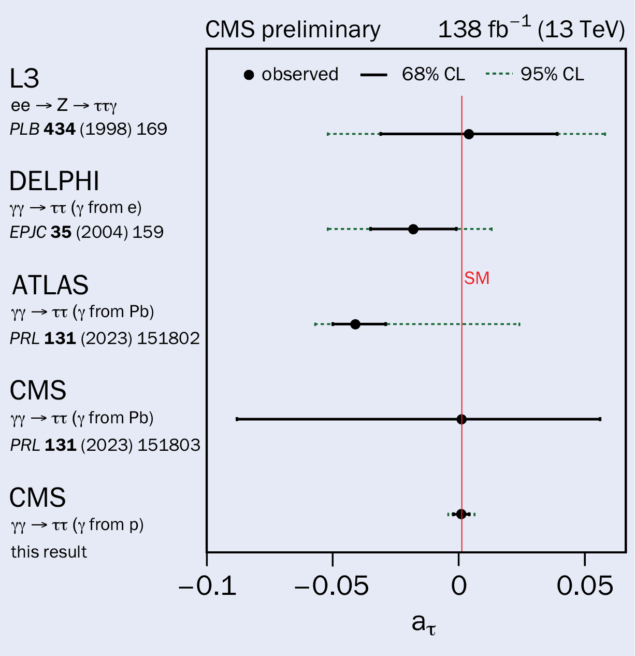A report from the CMS experiment

The CMS collaboration has reported the first observation of ?? → ?? in pp collisions. The results set a new benchmark for the tau lepton’s magnetic moment, surpassing previous constraints and paving the way for studies probing new physics.
For the tau lepton’s less massive cousins, measurements of magnetic moments offer exceptional sensitivity to beyond-the-Standard-Model (BSM) physics. In quantum electrodynamics (QED), quantum effects modify the Dirac equation, which predicts a gyromagnetic factor g precisely equal to two. The first-order correction, an effect of only α/2π, was calculated by Julian Schwinger in 1948. Taking into account higher orders too, the electron anomalous magnetic moment, a = (g–2)/2, is one of the most precisely measured quantities in physics and is in remarkable agreement with QED predictions. The g–2 of the muon has also been measured with high precision and shows a persistent discrepancy with certain theoretical predictions. By contrast, however, the tau lepton’s g–2 suffers from a lack of precision, given that its short lifetime makes direct measurements very challenging. If new-physics effects scale with the squared lepton mass, deviations from QED predictions in this measurement would be about 280 times larger than in the muon g–2 measurement.

Experimental insights on g–2 can be indirectly obtained by measuring the exclusive production of tau–lepton pairs created in photon–photon collisions. As charged particles pass each other at relativistic velocities in the LHC beampipe, they generate intense electromagnetic fields, leading to photon–photon collisions. The production of tau lepton pairs in photon collisions was first observed by the ATLAS and CMS collaborations in Pb–Pb runs. The CMS collaboration has now observed the same process in proton–proton (pp) data. When photon collisions occur in pp runs, the protons can remain intact. As a result, final-state particles can be produced exclusively, with no other particles coming from the same production vertex.
Tau–lepton tracks were isolated within just a millimetre around the interaction vertex
Separating these low particle multiplicity events from ordinary pp collisions is extremely challenging, as events “pile up” within the same bunch crossing. Thanks to the precise tracking capabilities of the CMS detector, tau–lepton tracks were isolated within just a millimetre around the interaction vertex. Figure 1 shows the resulting excess of ?? → ?? events rising above the estimated backgrounds when few additional tracks were observed within the selected 1 mm window.

This process was used to constrain a? using an effective-field-theory approach. BSM physics affecting g–2 would modify the expected number of ?? → ?? events, with the effect increasing with the di-tau invariant mass. Compared to Pb–Pb collisions, the pp data sample provides a more precise g–2 value because of the larger number of events and of the higher invariant masses probed, thanks to the higher energy of the photons. Using the invariant-mass distributions collected in pp collisions during the full LHC Run 2, the CMS collaboration has not observed any statistically significant deviations from the Standard Model. The tightest constraint ever on a? was set, as shown in figure 2. The uncertainty is only three times larger than the value of Schwinger’s correction.
Further reading
CMS Collab. 2024 CMS-PAS-SMP-23-005.







